What is Pork Chashu?
Chashu (チャーシュー or 焼豚) is a Japanese dish made by braising fatty pork belly in a soy-based sauce. It is commonly served on top of a bowl of hot ramen or rice (chashu don), and its slow cooking process results in an incredibly tender, melt-in-mouth texture.
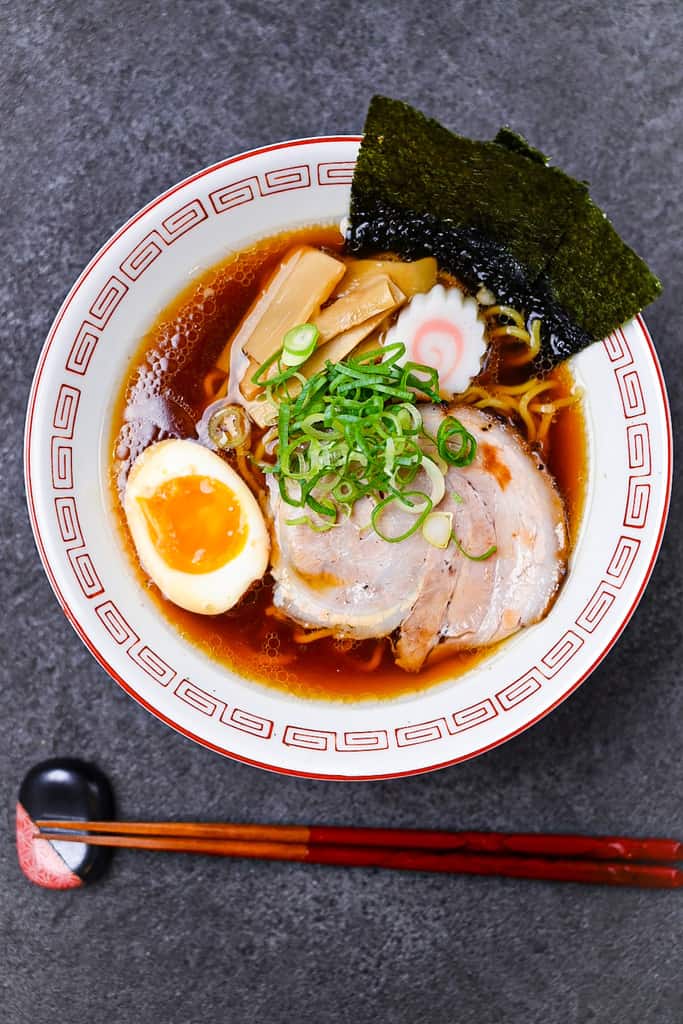
Although chashu originated from the Cantonese “Char Siu,” the Japanese version differs in both cooking method and flavor. Firstly, Japanese chashu is braised or simmered rather than barbecued or roasted. Japanese chashu is glazed with leftover broth to create a teriyaki-like effect, while Cantonese char siu has more of a barbecue flavor.
When making Japanese Chashu, the most common meat to use is pork belly. However, it can also be made with pork loin or shoulder, or even chicken for a variation called tori chashu.


How I Developed This Recipe
When I visit a ramen restaurant, one of the first things I notice is the chashu. In Japan, the term “chashu” covers a range of products, but there’s a significant difference between store-bought chashu and the kind you find in ramen shops.
With this in mind, my goal in creating this chashu recipe was to replicate the melt-in-your-mouth tenderness characteristic of ramen-restaurant chashu. This recipe does take a bit of time, but the result is well worth the effort.
The chashu turns out so tender and flavorful that it’s a perfect addition to ramen and dishes like fried rice!

Visual Walkthrough & Tips
Here are my step-by-step instructions for how to make melt-in-mouth Japanese Pork Chashu at home. For ingredient quantities and simplified instructions, scroll down for the Printable Recipe Card below.
If you prefer to watch the process in action, check out my YouTube video of this chashu recipe for a complete visual walkthrough!
1. Cooking the Pork
Stab the surface of the pork belly with a fork on both sides. This helps the pork absorb more flavor from the broth but also helps break down some of the tendons and proteins, resulting in a more tender chashu.
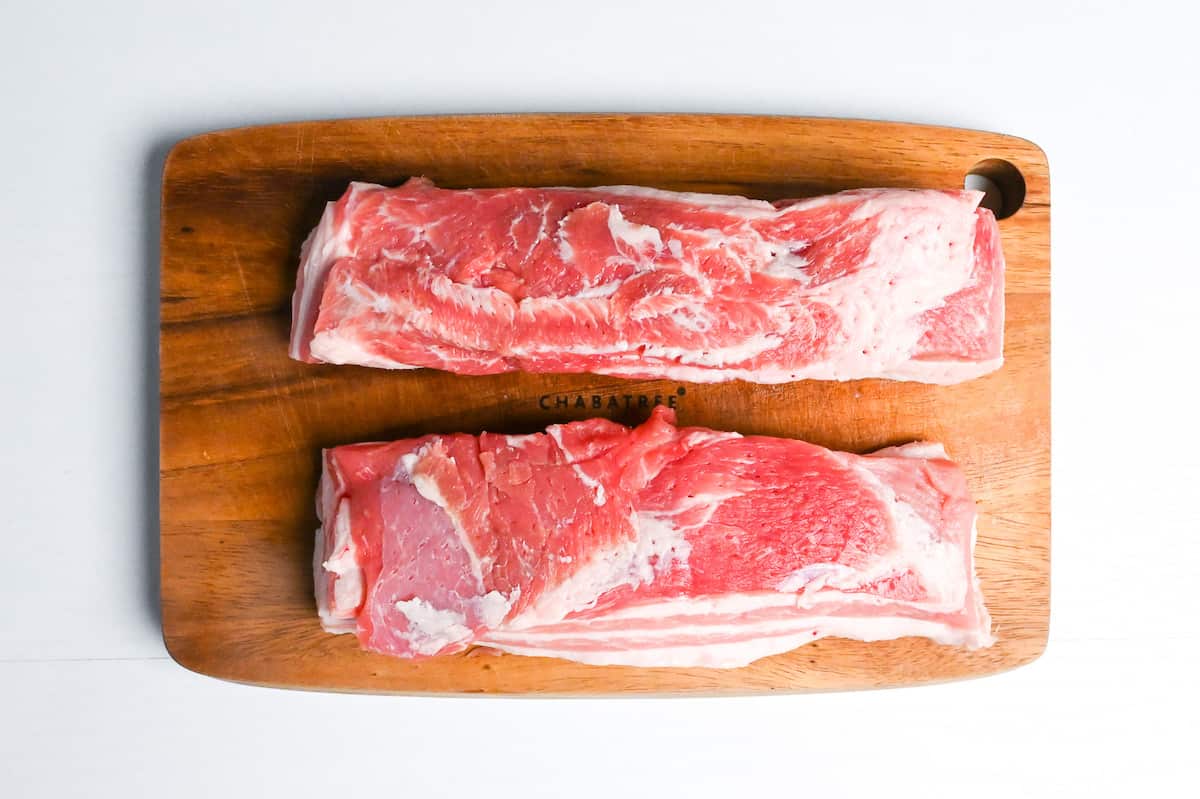
Start with the thinner side and roll up the pork. You can secure it either with butcher’s twine or a stretchable meat net.

Rolling the pork is mainly for the presentation and doesn’t affect the flavor, but if you decide not to roll it then you will need to shorten the cooking time to 1 hour 30 minutes.
Place the rolled pork belly in a large pot and fill with water until submerged (it’s okay if it’s poking out slightly). Bring to a boil over medium-high heat and then lower to a simmer. Scoop out any scum that forms on the top of the water.
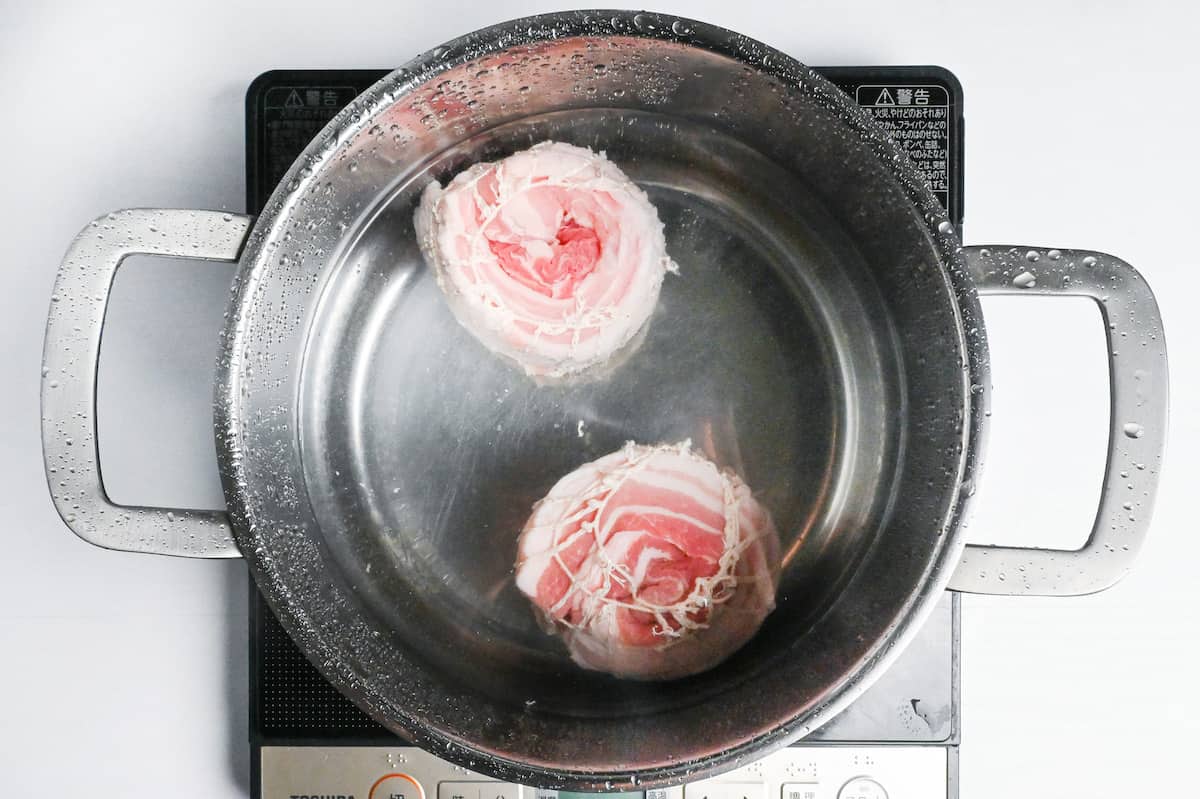
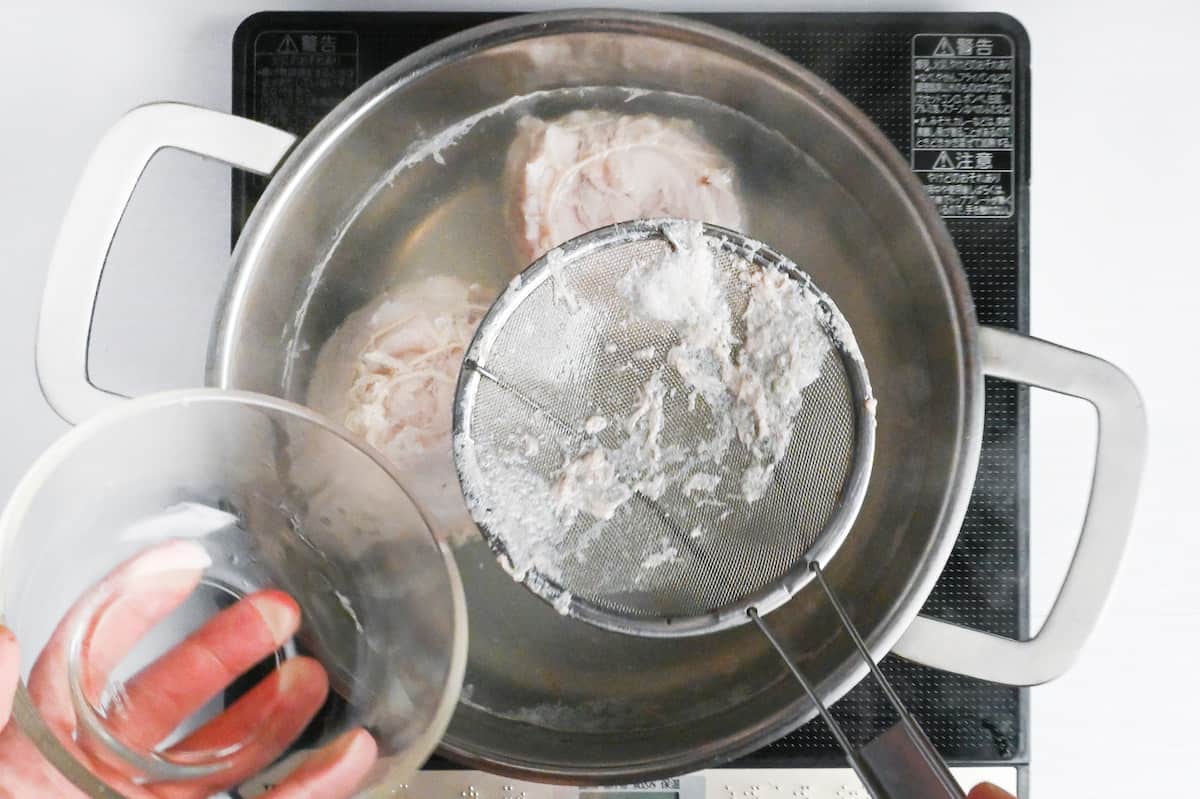
Add the green part of green onion, roughly chopped yellow onion, thick slices of fresh ginger, whole garlic cloves, and rice vinegar to the pot, and then cover with a drop-lid. You can use foil or baking paper if you don’t have a drop-lid. Check out my “How to Make a Drop Lid” post for more info.
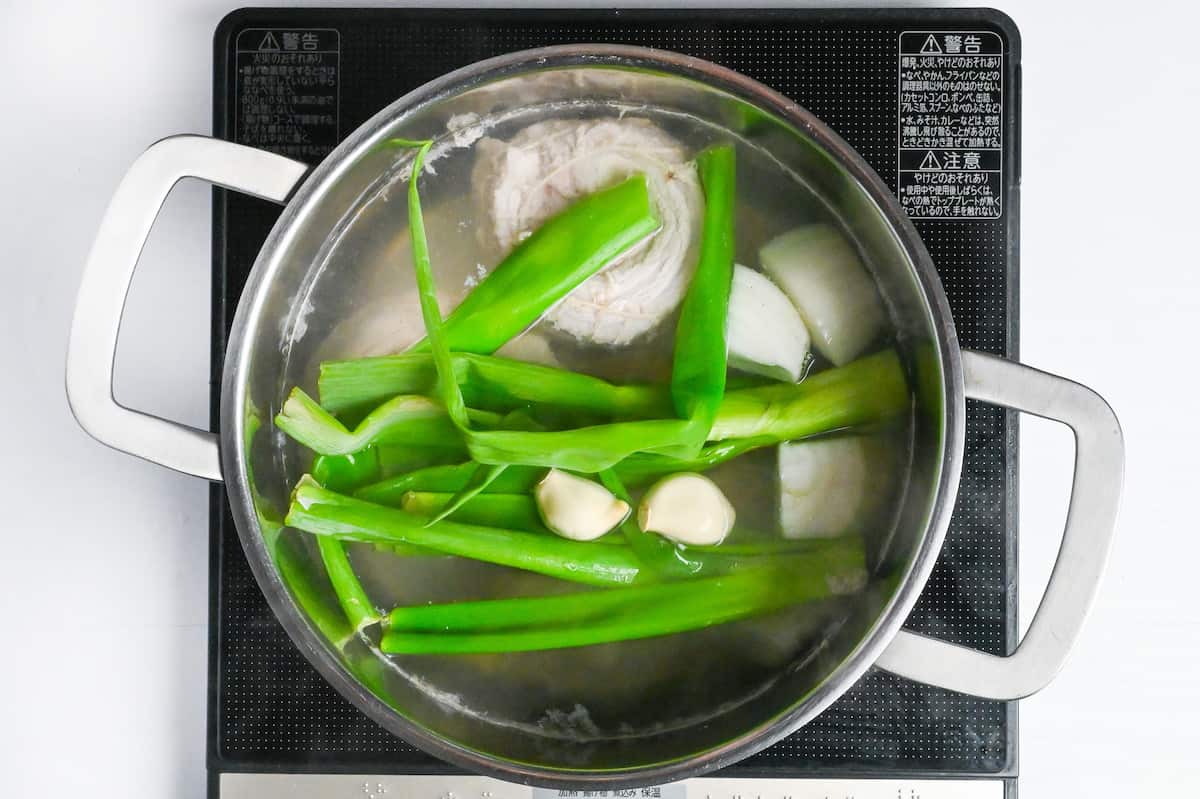

Adding vinegar to the broth helps tenderize the pork even further. Just be careful only to add a little, as we don’t want to make the broth sour.
Simmer on low heat for one hour, then turn the pork over and simmer for another hour. The total simmering time is 2 hours. (Reduce to 45 minutes on each side if your pork isn’t rolled.)
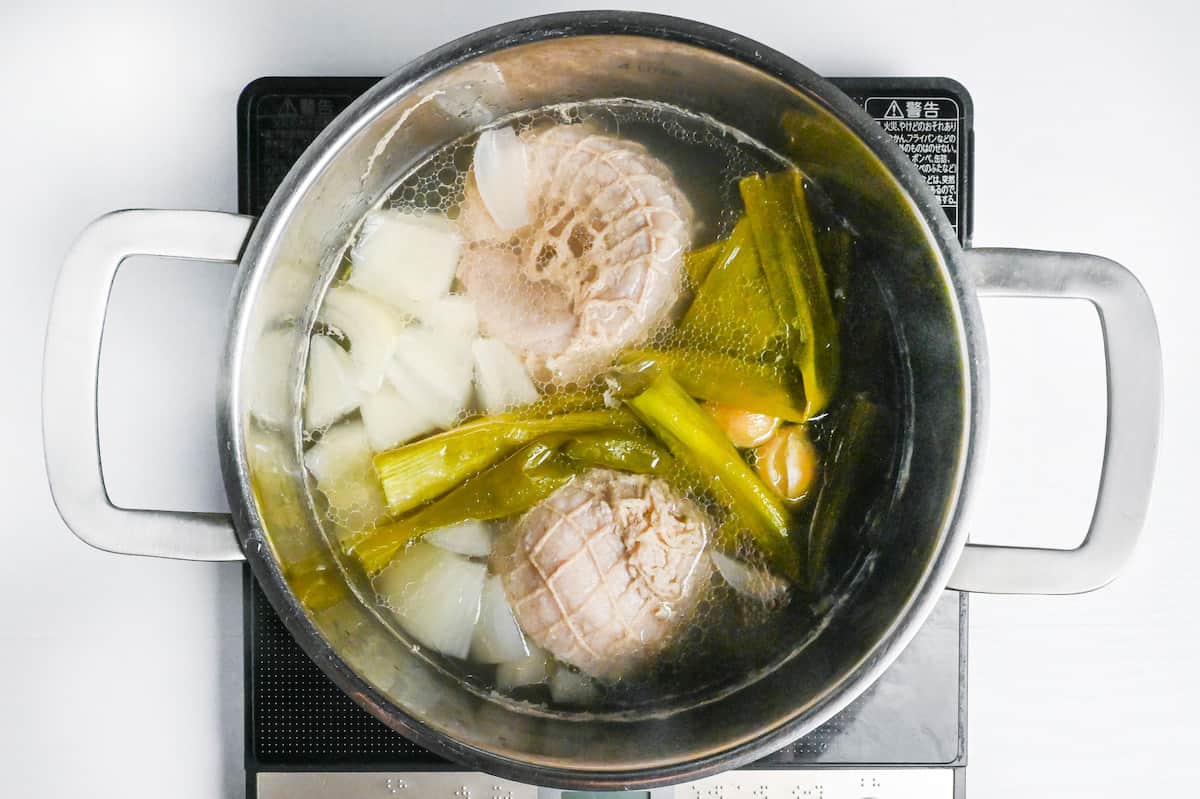
Once the two hours are up, transfer the chashu to an open zip-lock bag and leave to cool. Set aside 250ml of the pork broth ready to make the marinade.
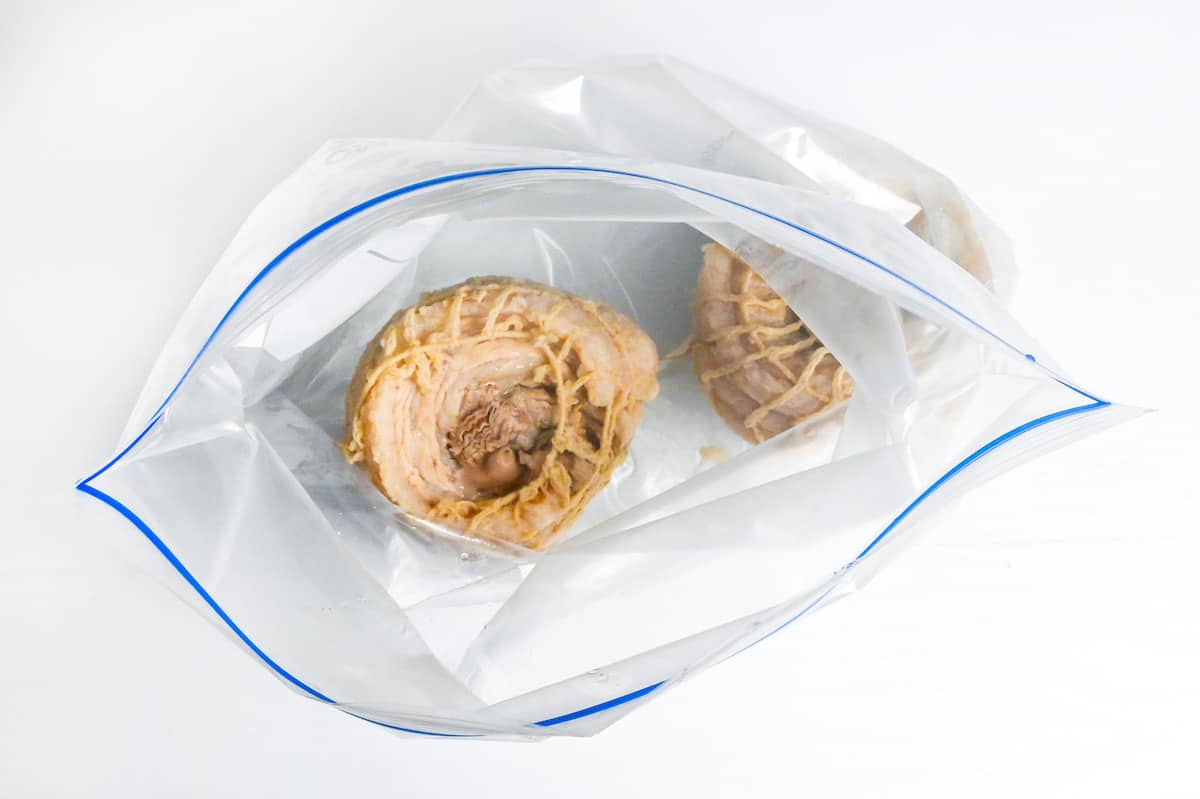
2. How to make the Marinade
Pour 250ml of the pork broth into a small saucepan. This will give the marinade more depth.
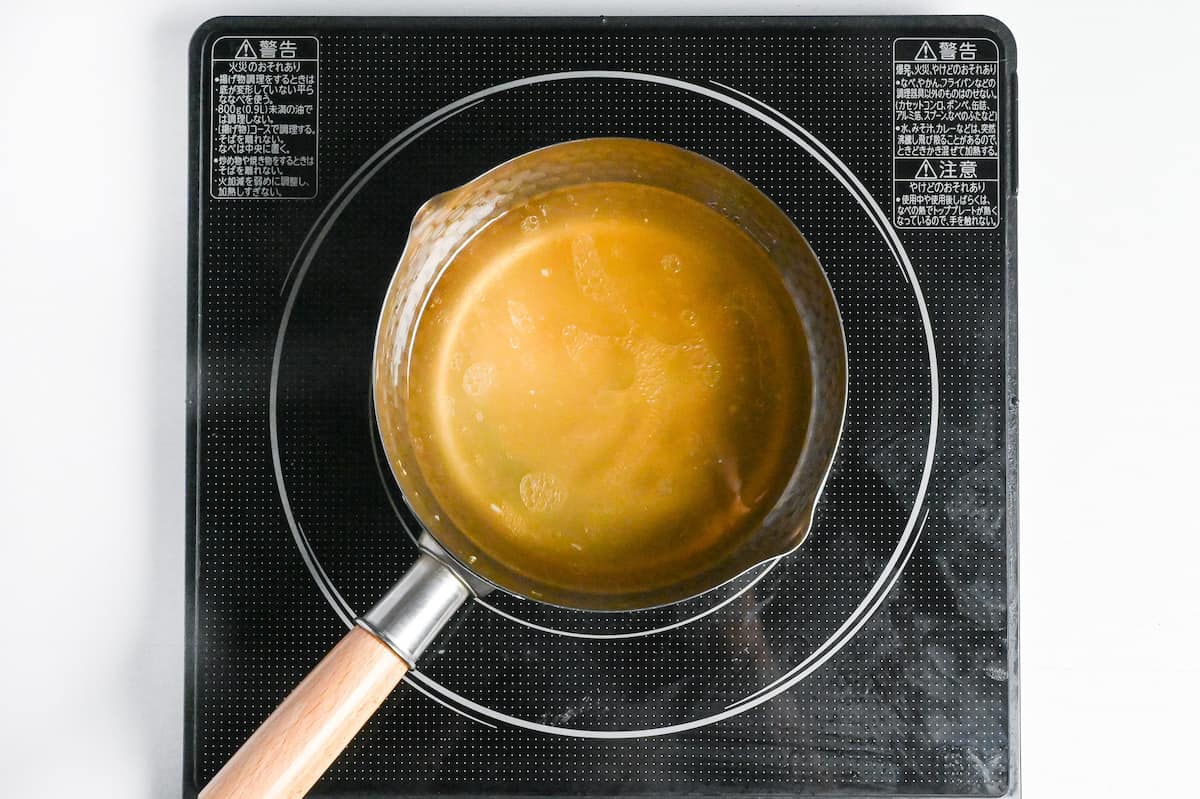
Add sake, mirin, soy sauce, and sugar to the pan and bring to a boil. Allow to boil for 1 minute and then remove it from the heat. Let it cool to room temperature.
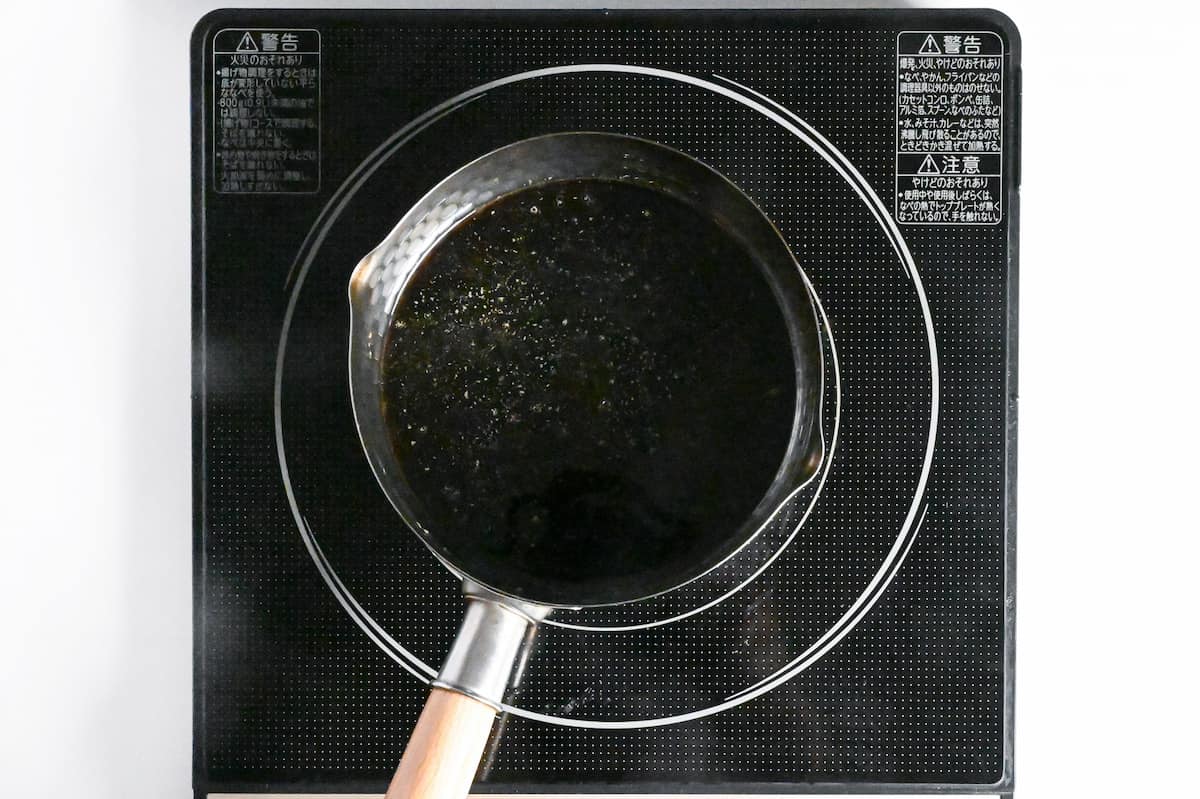
Pour the cooled marinade into the ziplock bag with the pork and marinate in the refrigerator for at least 12 hours (preferably overnight).
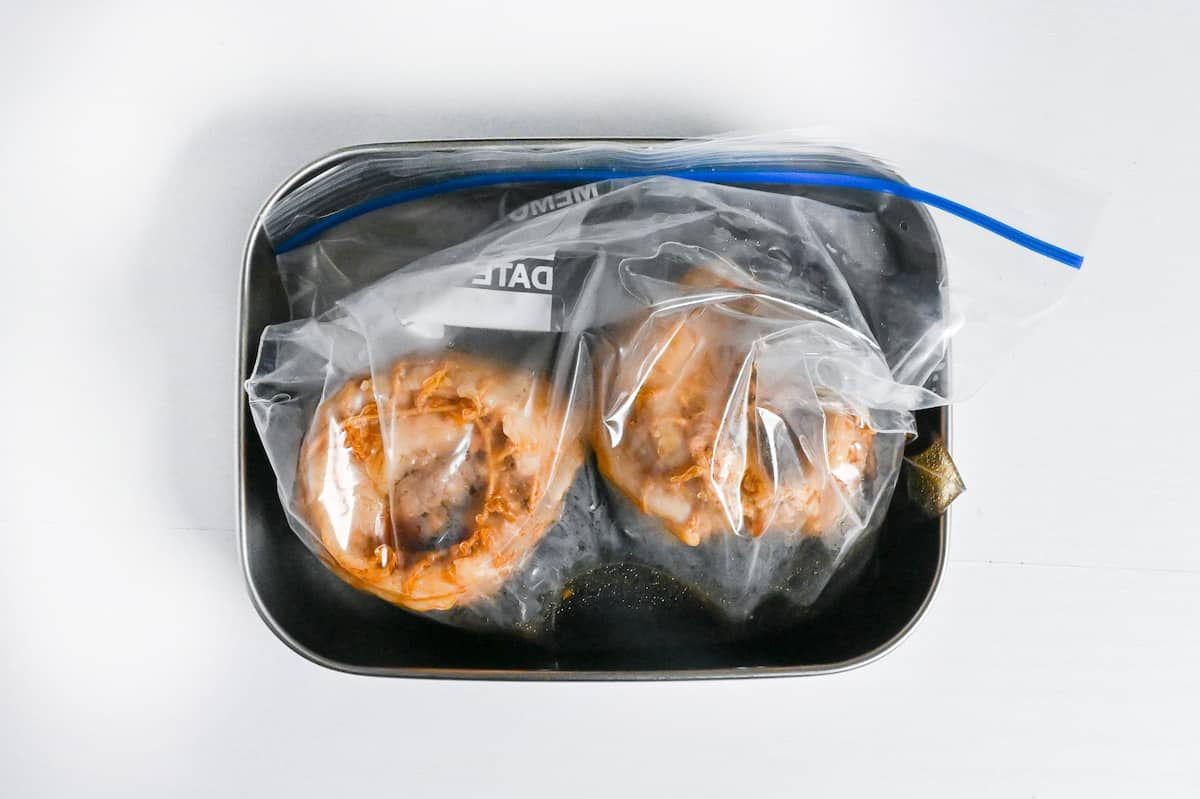
I usually place the bag in a tray to prevent any leaks and turn the pork every few hours to ensure it’s evenly marinated all over (this is optional though).
3. Glaze
Heat a dry pan (without oil) on medium-high, and add the marinated chashu once hot. Rotate occasionally to seal and slightly char all of the surface. This will improve both the texture and the taste. (You can leave the string on for this to stop it from falling apart.)
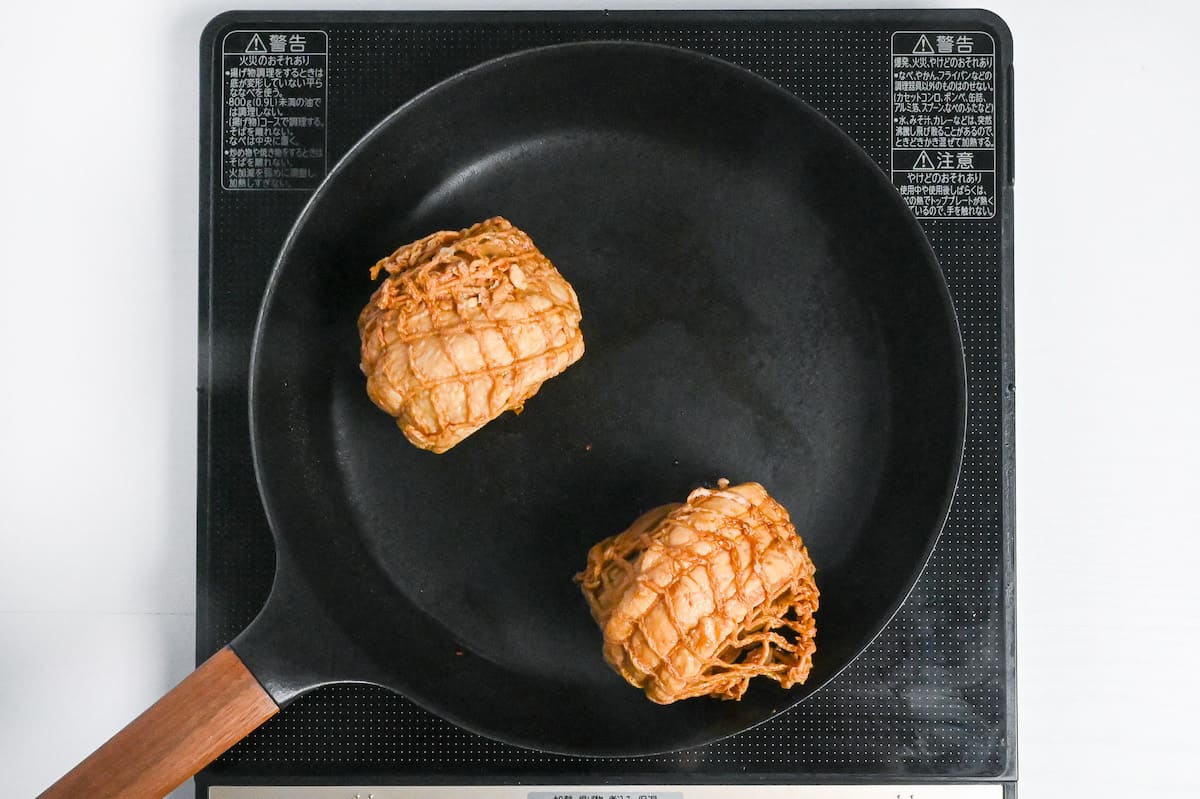
Once sealed, set aside on a plate.
Lower the heat to medium and pour in 100ml of leftover marinade.
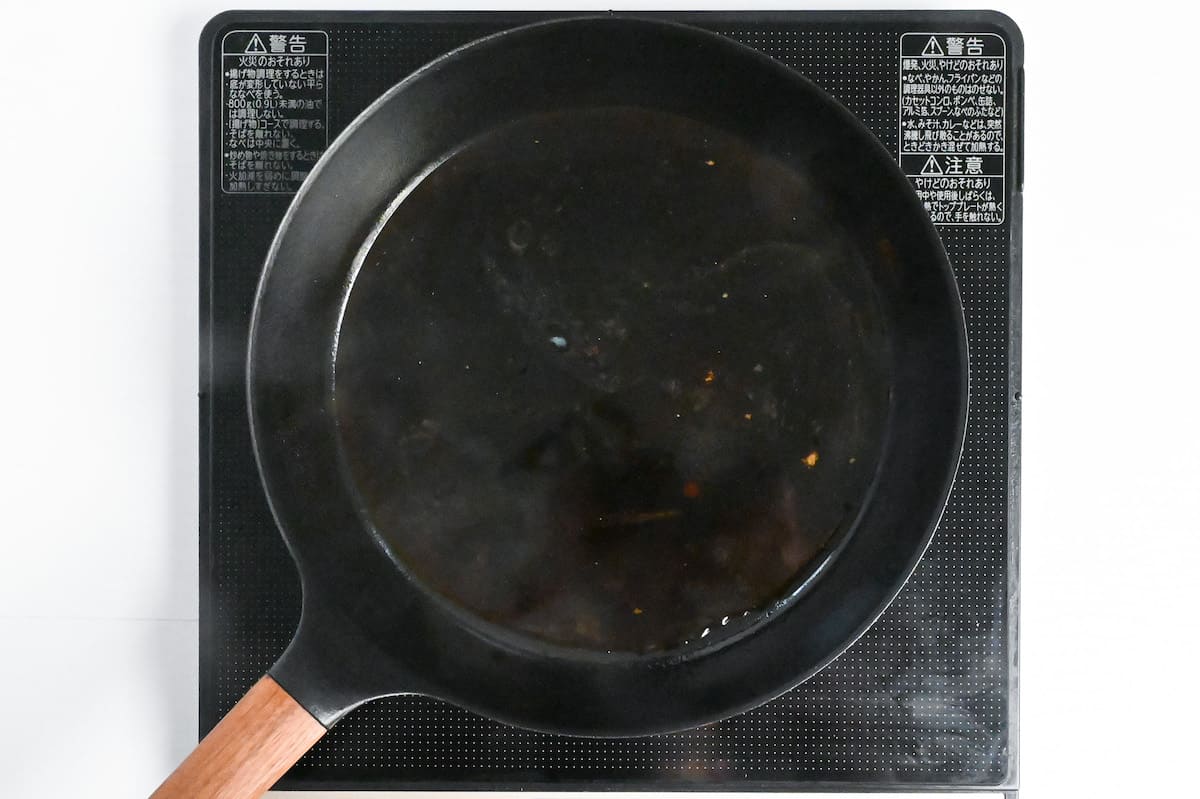
Once the marinade starts to thicken, place the pork back in the pan and rotate until it’s fully covered in the glaze. If the marinade starts to burn, take it off of the heat.
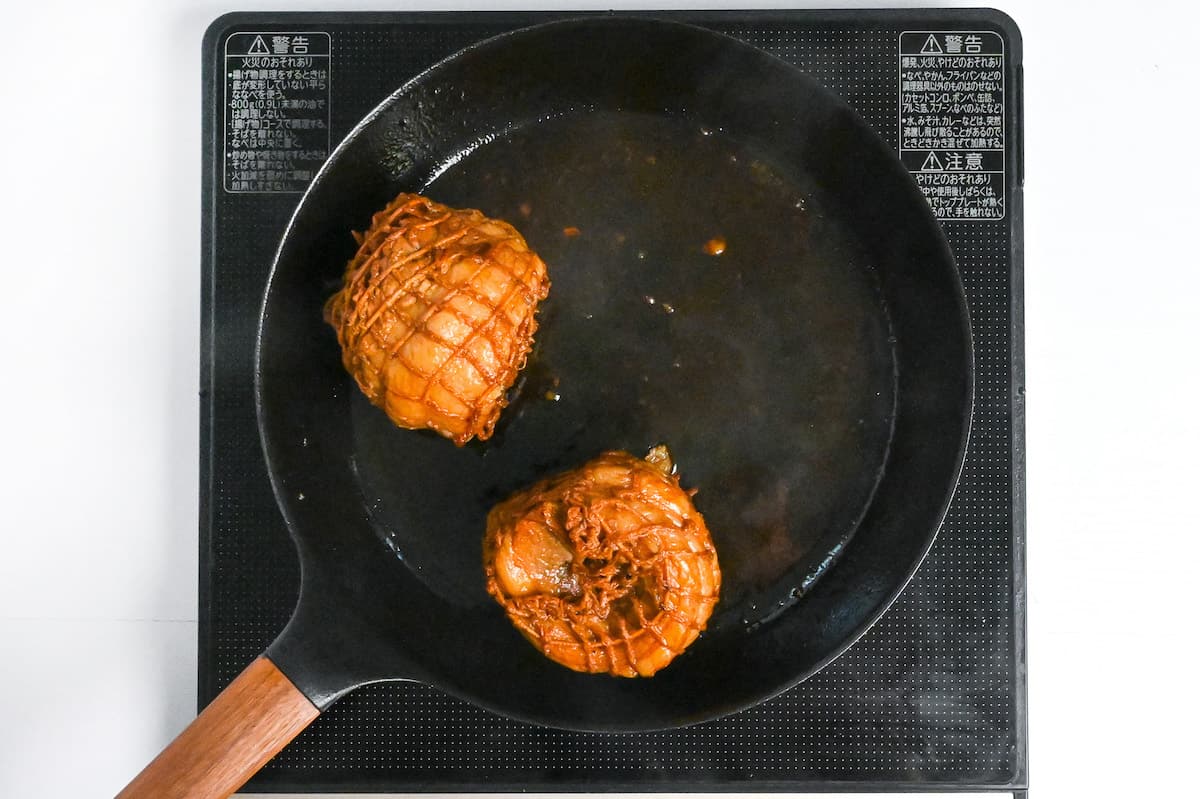
Heating the marinade in the pan like this causes the sugars in the liquid to caramelize, giving a bit of a teriyaki effect.
Once fully coated, leave to rest for 5-10 minutes.
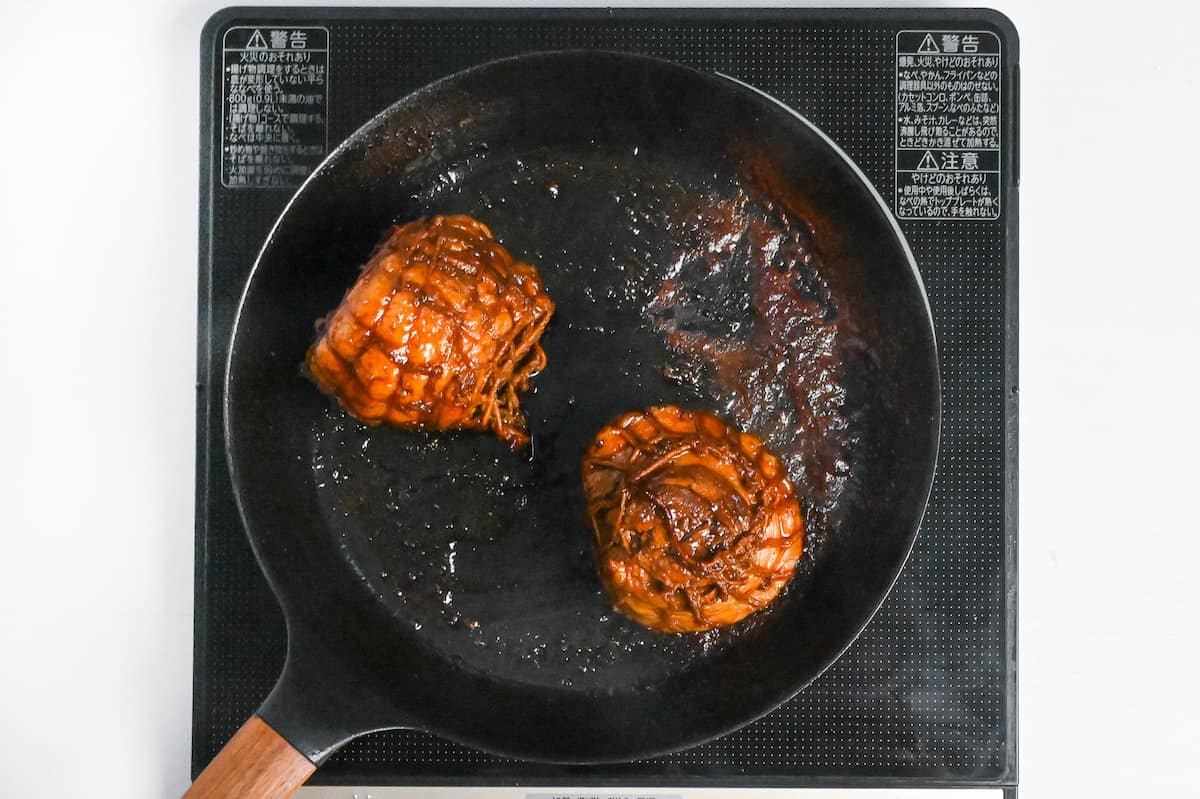
Remove the string and slice to your desired thickness.

Enjoy on ramen, donburi or even as a snack!
Jump to Full Recipe MeasurementsReusing the Broth and Marinade
After cooking, there will be leftover pork broth that can be used for ramen broths and soups. While some ramen restaurants keep adding new broth to old broth, there is no need to do this at home.
The leftover broth can be kept in the fridge for 3-4 days or in the freezer for up to 3 months so that it won’t go to waste.
After marinating the pork, there will be leftover marinade which can be reused once you remove the hardened fat. It can be used as a condiment in place of soy sauce, as well as used to make ramen restaurant-style fried rice and marinate boiled eggs to make ajitama eggs.
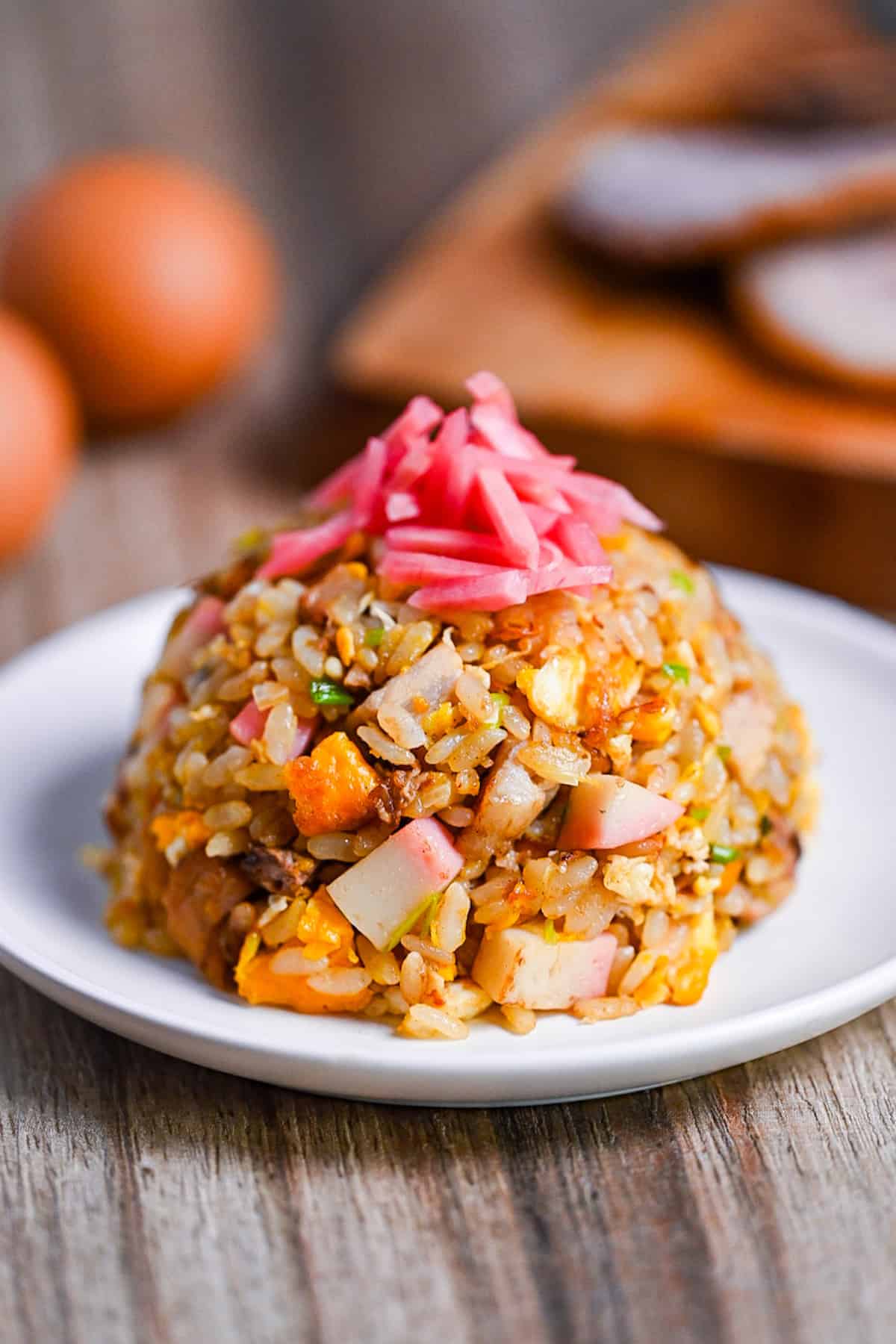
How to Store
It takes time and effort to make homemade chashu, but the effort is worth it. It should always be refrigerated or frozen to keep it fresh and delicious for as long as possible.
Refrigerated, it can last up to 3 days in an airtight Tupperware container. If freezing, slice the chashu before wrapping it in food-grade plastic wrap and placing it in a zipper freezer bag. Make sure to remove any air and seal the bag before placing it in the freezer.
Storage summary
Room temperature – Not recommended.
Refrigerated – Up to 3 days.
Frozen – Up to a month.
FAQ
The most common cut used for Japanese chashu pork is pork belly, but some restaurants and families opt for other cuts of pork or even chicken.
When a recipe specifies “sake,” selecting the appropriate type can be perplexing, particularly when the choice is between regular or cooking sake. On Sudachi, “sake” specifically denotes pure sake that doesn’t contain added salt, distinguishing it from cooking sake. Therefore, if your choice is cooking sake that includes salt, remember to adjust the salt levels in the recipe to compensate.
Note that all recipes on Sudachi use drinking sake. For a deeper understanding of sake’s role in Japanese cooking, including tips on the right selection and possible substitutes, consult our Sake 101 post, authored by a culinary expert with over three decades of experience in the field.
There’s no doubt that chashu originates from Chinese Char Siu. It traveled to Japan, then Japanese people found their own way to cook it.
It’s usually served on Ramen but sometimes with rice bowls. You can check out my chashu donburi recipe here. There are even some izakayas (Japanese Tapas-style restaurant) that serve Chashu on its own as a beer snack!
Chashu is a block of pork belly that has been simmered and braised.

I hope you enjoy this Chashu Pork recipe! If you try it out, I’d really appreciate it if you could spare a moment to let me know what you thought by giving a review and star rating in the comments below. It’s also helpful to share any adjustments you made to the recipe with our other readers. Thank you!
Recommended Ramen Recipes
Hungry for more? Explore my authentic ramen recipe collection to find your next favorite dishes!

Japanese Chashu Pork (Braised Pork Belly for Ramen)
Ingredients
Part 1
- 700 g slab skinless pork belly with a good balance of fat and lean meat
- 50 g Japanese leek (naganegi) green part
- 50 g ginger root thickly sliced
- 3 cloves garlic whole and peeled
- 100 g onion roughly cut
- 1 tsp rice vinegar
Part 2
- 50 ml sake
- 1 tbsp mirin
- 250 ml pork stock from part 1
- 150 ml Japanese soy sauce (koikuchi shoyu)
- 30 g sugar
My recommended brands of ingredients and seasonings can be found in my Japanese pantry guide.
Can’t find certain Japanese ingredients? See my substitution guide here.
Instructions
Part 1
- Take 700 g slab skinless pork belly and pierce both sides with a fork.

- Dry the pork belly with a paper towel and roll. Start with the thinnest side and roll it up, secure with string or meat netting. (See video for how to tie with string.)

- Place the pork into a deep pot, fill with cold water until the pork is just about submerged. (It’s okay if the highest part is slightly poking out the top.)

- Turn the heat on a medium-high setting and bring the water to a boil. If any scum floats on the top, scoop it out.

- Once it's boiling, lower the heat to a simmer and add 50 g Japanese leek (naganegi), 100 g onion, 50 g ginger root, 3 cloves garlic and 1 tsp rice vinegar.

- Place a drop lid on top (see post for how to make your own drop lid) and then allow to simmer on a low heat for 1 hour.

- Once the time has passed, remove the drop lid, carefully flip the pork over onto the other side and place the drop lid back. Simmer for another hour.

- After the time is up, turn off the heat, remove the pork from the broth and place it in a large ziplock bag.

Part 2
- Scoop 250 ml pork stock leftover from the pot and pour it into a saucepan.

- Add 50 ml sake, 1 tbsp mirin, 150 ml Japanese soy sauce (koikuchi shoyu) and 30 g sugar to the pan and boil for 1 minute.

- Turn off the heat and leave it to cool slightly. Once cooled, pour it into the ziplock bag with the pork. Seal the bag and marinate in the fridge for at least 12 hours (preferably overnight).

Part 3
- Heat a frying pan on a medium-high heat. Once it’s hot, add the pork belly to the pan and lightly char the outside. Keep turning the pork to make sure all the edges are evenly charred.

- Transfer the pork to a plate and pour 100ml of the leftover chashu marinade into the pan.

- Allow the sauce to thicken slightly and place the pork back in.

- Keep turning the pork to coat the surface with the glaze. Once fully covered, remove it from the pan and allow it to rest for 5-10 minutes.

- Remove the rope or net and then cut the chashu into slices.

- Enjoy with ramen or on rice as chashu donburi!
Video

Notes
- Remove the ginger, spring onion and garlic at the end of the simmering time and store leftover pork stock in the fridge for up to 1 week or 1 month in the freezer. You can use it for soups and broths.
- You can soak boiled and peeled eggs in the ziplock bag with the leftover broth to make ramen eggs. Scoop out the pork fat before adding the eggs.
- The chashu pork can be kept in the fridge for 3 days or 1 month in the freezer. I recommend slicing it first for convenience.
- Rolling the pork belly is for decoration and is optional. You can still make delicious chashu without rolling it. If you don’t roll it, reduce the cooking time to 45 minutes on each side. (1 hour 30 minutes total)
- Repurpose chashu end cuts for chahan fried rice or chashu rice bowls.
- Use a cast iron pan instead of non-stick for final searing to achieve better caramelization.
- For a quicker and easier alternative, try my oven-baked version of pork chashu.




Hi, if i use smaller meat, say 250g, will the cooking time be the same or faster?
Thanks
Hi Clara,
Thank you for your question. I haven’t tried the recipe with a smaller piece of meat but in theory it would cook a bit faster. However this recipe is already a quick chashu (they usually take 3-4 hours at least) so I recommend cooking it for the time stated to ensure it’s flavourful. Hope it helps!
Hello, on part 3, what can i do with left over sauce in the bag? It is a lot though, i feel guilty to throw it away. And how can i store it ?
Hi Tram,
Thank you for trying my recipe and giving a 5 star review!
You can reuse the broth to make ramen eggs, my ramen restaurant style chahan (fried rice) or simply use it again to make another batch of chashu.
You can store it for 3-4 days in the fridge or 3 months in a zip lock bag in the freezer. If you’re freezing it, I recommend freezing it in an ice cube tray, you could add it to dishes in small amounts for extra umami.
Hope that helps!